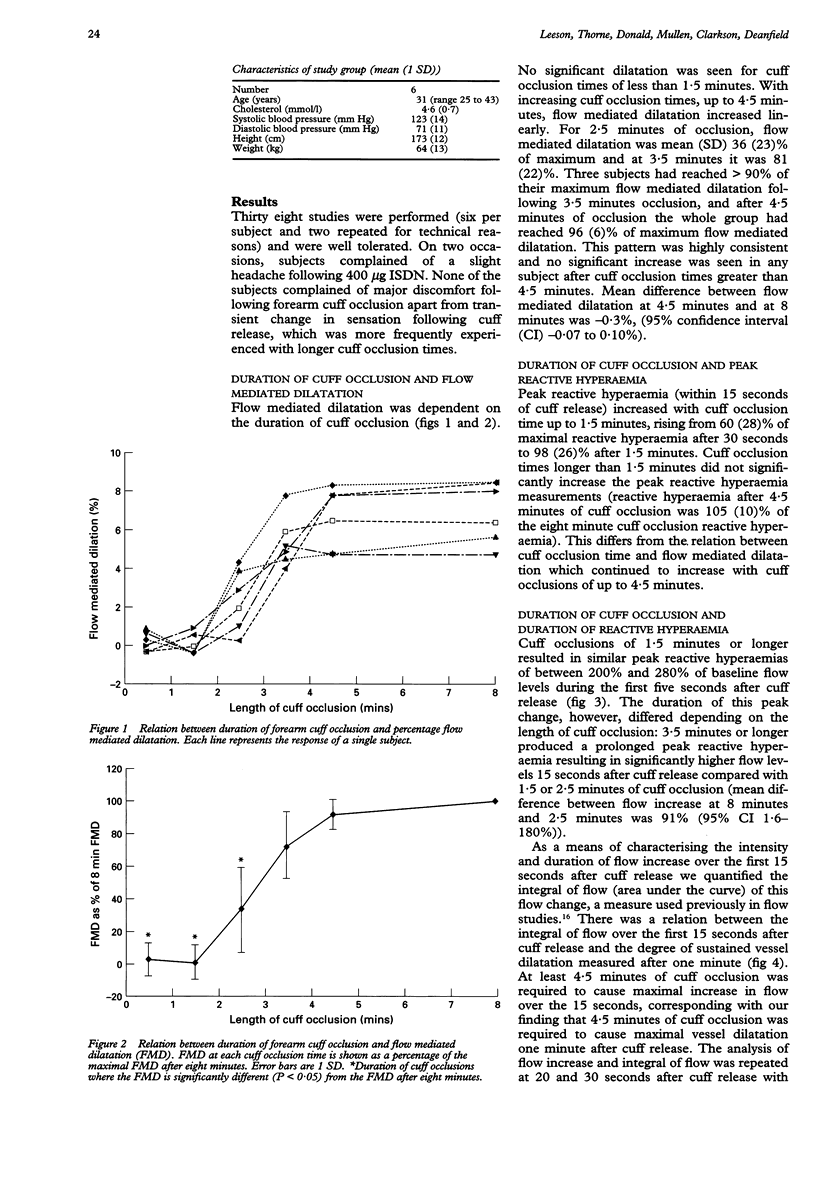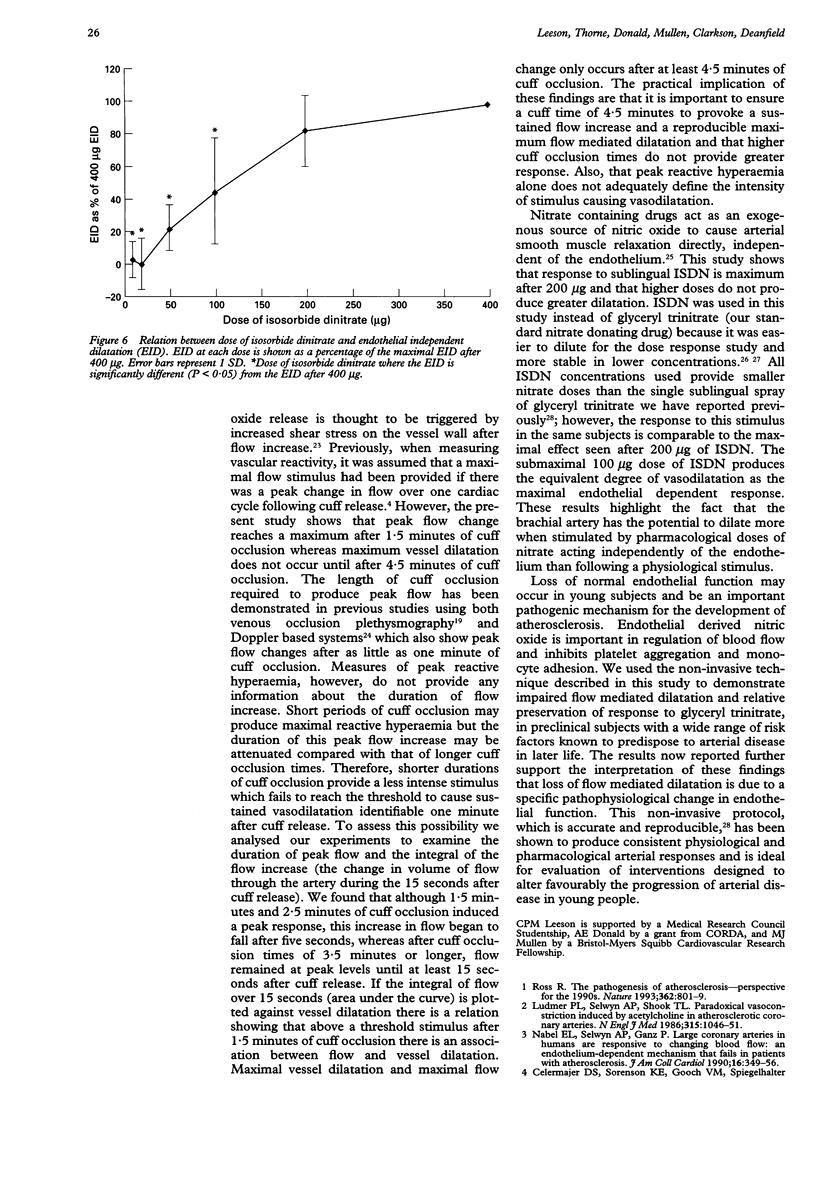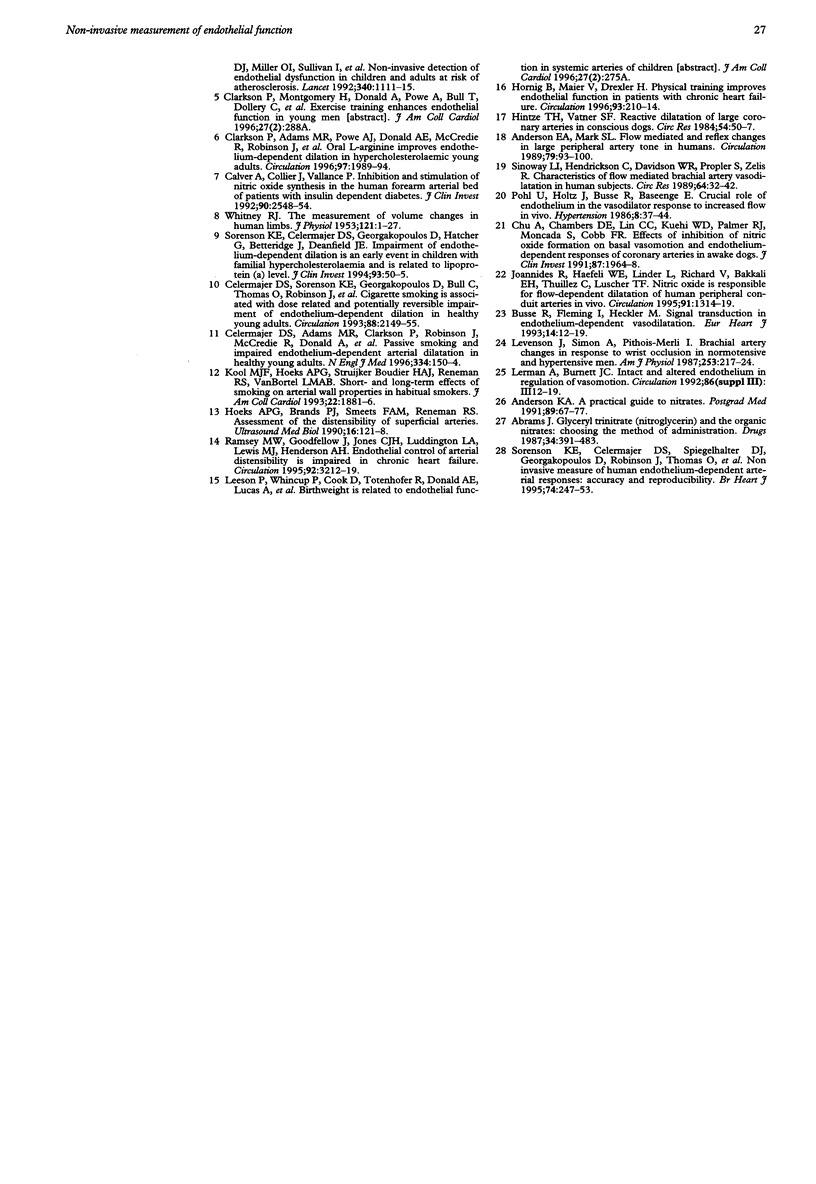Abstract
OBJECTIVE: To examine the relation between endothelial dependent and endothelial independent stimuli of varying intensity and measures of vascular function in the brachial artery of young healthy adults, to determine whether these responses are consistent and can be used to assess endothelial function. DESIGN AND SETTING: High resolution ultrasound was used to measure brachial artery diameter at rest, after reactive hyperaemia induced by forearm cuff occlusion, and after sublingual isosorbide dinitrate (ISDN). Each subject was assigned to a random order of six cuff occlusion times (30 seconds, 1.5, 2.5, 3.5, 4.5, and 8 minutes) and six doses of ISDN (10, 20, 50, 100, 200, and 400 micrograms). SUBJECTS: Three males and three females mean age 31 years (range 25 to 43) with no known risk factors for cardiovascular disease. MAIN OUTCOME MEASURES: Flow mediated, endothelial dependent dilatation was compared to duration of cuff occlusion, peak reactive hyperaemia, and duration of increased flow. Nitrate induced, endothelial independent dilatation was compared to dose of ISDN and change in flow. RESULTS: Vessel dilatation and duration of peak flow change increased with longer duration of cuff occlusion. After 4.5 minutes of occlusion, flow mediated dilatation was mean (SD) 96 (6)% of maximal response and did not increase significantly with longer occlusion times. No significant dilatation occurred after 10 or 20 micrograms of ISDN in any subject. With increasing doses up to 200 micrograms there was an increase in dilatation. Endothelial independent dilatation did not increase significantly with doses of ISDN above 200 micrograms. CONCLUSIONS: Measures of arterial function vary with duration of blood flow occlusion and ISDN dose. Maximum arterial response was reached in all subjects after 4.5 minutes of blood flow occlusion or 200 micrograms of ISDN. Therefore, these variables produce consistent reproducible measures of endothelial function.
Full text
PDF





Selected References
These references are in PubMed. This may not be the complete list of references from this article.
- Abrams J. Glyceryl trinitrate (nitroglycerin) and the organic nitrates. Choosing the method of administration. Drugs. 1987 Sep;34(3):391–403. doi: 10.2165/00003495-198734030-00005. [DOI] [PubMed] [Google Scholar]
- Anderson E. A., Mark A. L. Flow-mediated and reflex changes in large peripheral artery tone in humans. Circulation. 1989 Jan;79(1):93–100. doi: 10.1161/01.cir.79.1.93. [DOI] [PubMed] [Google Scholar]
- Calver A., Collier J., Vallance P. Inhibition and stimulation of nitric oxide synthesis in the human forearm arterial bed of patients with insulin-dependent diabetes. J Clin Invest. 1992 Dec;90(6):2548–2554. doi: 10.1172/JCI116149. [DOI] [PMC free article] [PubMed] [Google Scholar]
- Celermajer D. S., Adams M. R., Clarkson P., Robinson J., McCredie R., Donald A., Deanfield J. E. Passive smoking and impaired endothelium-dependent arterial dilatation in healthy young adults. N Engl J Med. 1996 Jan 18;334(3):150–154. doi: 10.1056/NEJM199601183340303. [DOI] [PubMed] [Google Scholar]
- Celermajer D. S., Sorensen K. E., Georgakopoulos D., Bull C., Thomas O., Robinson J., Deanfield J. E. Cigarette smoking is associated with dose-related and potentially reversible impairment of endothelium-dependent dilation in healthy young adults. Circulation. 1993 Nov;88(5 Pt 1):2149–2155. doi: 10.1161/01.cir.88.5.2149. [DOI] [PubMed] [Google Scholar]
- Celermajer D. S., Sorensen K. E., Gooch V. M., Spiegelhalter D. J., Miller O. I., Sullivan I. D., Lloyd J. K., Deanfield J. E. Non-invasive detection of endothelial dysfunction in children and adults at risk of atherosclerosis. Lancet. 1992 Nov 7;340(8828):1111–1115. doi: 10.1016/0140-6736(92)93147-f. [DOI] [PubMed] [Google Scholar]
- Chu A., Chambers D. E., Lin C. C., Kuehl W. D., Palmer R. M., Moncada S., Cobb F. R. Effects of inhibition of nitric oxide formation on basal vasomotion and endothelium-dependent responses of the coronary arteries in awake dogs. J Clin Invest. 1991 Jun;87(6):1964–1968. doi: 10.1172/JCI115223. [DOI] [PMC free article] [PubMed] [Google Scholar]
- Clarkson P., Adams M. R., Powe A. J., Donald A. E., McCredie R., Robinson J., McCarthy S. N., Keech A., Celermajer D. S., Deanfield J. E. Oral L-arginine improves endothelium-dependent dilation in hypercholesterolemic young adults. J Clin Invest. 1996 Apr 15;97(8):1989–1994. doi: 10.1172/JCI118632. [DOI] [PMC free article] [PubMed] [Google Scholar]
- Hintze T. H., Vatner S. F. Reactive dilation of large coronary arteries in conscious dogs. Circ Res. 1984 Jan;54(1):50–57. doi: 10.1161/01.res.54.1.50. [DOI] [PubMed] [Google Scholar]
- Hoeks A. P., Brands P. J., Smeets F. A., Reneman R. S. Assessment of the distensibility of superficial arteries. Ultrasound Med Biol. 1990;16(2):121–128. doi: 10.1016/0301-5629(90)90139-4. [DOI] [PubMed] [Google Scholar]
- Hornig B., Maier V., Drexler H. Physical training improves endothelial function in patients with chronic heart failure. Circulation. 1996 Jan 15;93(2):210–214. doi: 10.1161/01.cir.93.2.210. [DOI] [PubMed] [Google Scholar]
- Joannides R., Haefeli W. E., Linder L., Richard V., Bakkali E. H., Thuillez C., Lüscher T. F. Nitric oxide is responsible for flow-dependent dilatation of human peripheral conduit arteries in vivo. Circulation. 1995 Mar 1;91(5):1314–1319. doi: 10.1161/01.cir.91.5.1314. [DOI] [PubMed] [Google Scholar]
- Kool M. J., Hoeks A. P., Struijker Boudier H. A., Reneman R. S., Van Bortel L. M. Short- and long-term effects of smoking on arterial wall properties in habitual smokers. J Am Coll Cardiol. 1993 Dec;22(7):1881–1886. doi: 10.1016/0735-1097(93)90773-t. [DOI] [PubMed] [Google Scholar]
- Ludmer P. L., Selwyn A. P., Shook T. L., Wayne R. R., Mudge G. H., Alexander R. W., Ganz P. Paradoxical vasoconstriction induced by acetylcholine in atherosclerotic coronary arteries. N Engl J Med. 1986 Oct 23;315(17):1046–1051. doi: 10.1056/NEJM198610233151702. [DOI] [PubMed] [Google Scholar]
- Nabel E. G., Selwyn A. P., Ganz P. Large coronary arteries in humans are responsive to changing blood flow: an endothelium-dependent mechanism that fails in patients with atherosclerosis. J Am Coll Cardiol. 1990 Aug;16(2):349–356. doi: 10.1016/0735-1097(90)90584-c. [DOI] [PubMed] [Google Scholar]
- Pohl U., Holtz J., Busse R., Bassenge E. Crucial role of endothelium in the vasodilator response to increased flow in vivo. Hypertension. 1986 Jan;8(1):37–44. doi: 10.1161/01.hyp.8.1.37. [DOI] [PubMed] [Google Scholar]
- Ramsey M. W., Goodfellow J., Jones C. J., Luddington L. A., Lewis M. J., Henderson A. H. Endothelial control of arterial distensibility is impaired in chronic heart failure. Circulation. 1995 Dec 1;92(11):3212–3219. doi: 10.1161/01.cir.92.11.3212. [DOI] [PubMed] [Google Scholar]
- Ross R. The pathogenesis of atherosclerosis: a perspective for the 1990s. Nature. 1993 Apr 29;362(6423):801–809. doi: 10.1038/362801a0. [DOI] [PubMed] [Google Scholar]
- Sinoway L. I., Hendrickson C., Davidson W. R., Jr, Prophet S., Zelis R. Characteristics of flow-mediated brachial artery vasodilation in human subjects. Circ Res. 1989 Jan;64(1):32–42. doi: 10.1161/01.res.64.1.32. [DOI] [PubMed] [Google Scholar]
- Sorensen K. E., Celermajer D. S., Georgakopoulos D., Hatcher G., Betteridge D. J., Deanfield J. E. Impairment of endothelium-dependent dilation is an early event in children with familial hypercholesterolemia and is related to the lipoprotein(a) level. J Clin Invest. 1994 Jan;93(1):50–55. doi: 10.1172/JCI116983. [DOI] [PMC free article] [PubMed] [Google Scholar]
- Sorensen K. E., Celermajer D. S., Spiegelhalter D. J., Georgakopoulos D., Robinson J., Thomas O., Deanfield J. E. Non-invasive measurement of human endothelium dependent arterial responses: accuracy and reproducibility. Br Heart J. 1995 Sep;74(3):247–253. doi: 10.1136/hrt.74.3.247. [DOI] [PMC free article] [PubMed] [Google Scholar]
- WHITNEY R. J. The measurement of volume changes in human limbs. J Physiol. 1953 Jul;121(1):1–27. doi: 10.1113/jphysiol.1953.sp004926. [DOI] [PMC free article] [PubMed] [Google Scholar]


